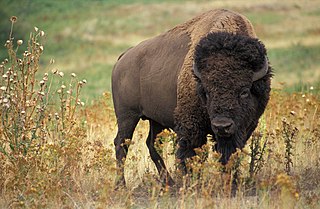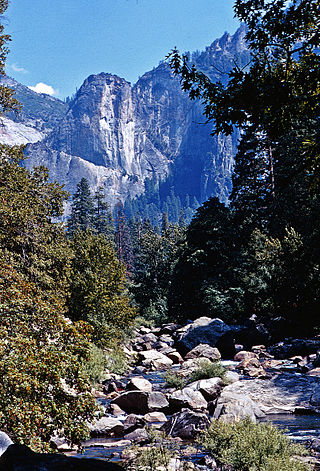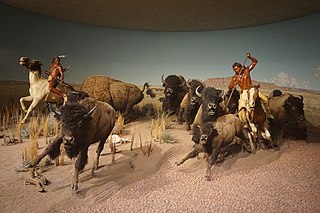Related Research Articles

A bison is a large bovine in the genus Bison within the tribe Bovini. Two extant and numerous extinct species are recognised.

</ref> Yellowstone was the first national park in the U.S. and is also widely held to be the first national park in the world. The park is known for its wildlife and its many geothermal features, especially the Old Faithful geyser, one of its most popular. While it represents many types of biomes, the subalpine forest is the most abundant. It is part of the South Central Rockies forests ecoregion.
The conservation movement, also known as nature conservation, is a political, environmental, and social movement that seeks to manage and protect natural resources, including animal, fungus, and plant species as well as their habitat for the future. Conservationists are concerned with leaving the environment in a better state than the condition they found it in. Evidence-based conservation seeks to use high quality scientific evidence to make conservation efforts more effective.

Elk Island National Park is a national park in Alberta, Canada, that played an important part in the conservation of the Plains bison. The park is administered by the Parks Canada Agency. This "island of conservation" is 35 km (22 mi) east of Edmonton, along the Yellowhead Highway, which goes through the park. It is Canada's eighth smallest in area but largest fully enclosed national park, with an area of 194 km2 (75 sq mi).

Madison Grant was an American lawyer, zoologist, anthropologist, and writer known for his work as a conservationist, eugenicist, and advocate of scientific racism. Grant is less noted for his far-reaching achievements in conservation than for his pseudoscientific advocacy of Nordicism, a form of racism which views the "Nordic race" as superior.

Theodore Roosevelt National Park is an American national park of the badlands in western North Dakota comprising three geographically separated areas. Honoring U.S. President Theodore Roosevelt, it is the only American national park named directly after a single person.

George Bird Grinnell was an American anthropologist, historian, naturalist, and writer. Originally specializing in zoology, he became a prominent early conservationist and student of Native American life. Grinnell has been recognized for his influence on public opinion and work on legislation to preserve the American bison. Mount Grinnell in Glacier National Park in Montana is named after him.
Wild Montana is a grassroots conservation organization founded by a group of Montana outfitters, ranchers, doctors, and friends. The organization is governed by a board of directors from across Montana, working at the local level through seven chapters in Helena, Bozeman, Missoula, Whitefish, Great Falls, Billings, and Butte. Each chapter is governed by a local board of directors. Since 1958, Wild Montana has worked to protect Montana's wilderness, wildlife habitat, and traditional recreation opportunities. The organization was instrumental in the passage of the 1964 Wilderness Act and in the designation of every Wilderness area in the state, like the Bob Marshall, Scapegoat, and Absaroka-Beartooth Wildernesses. It also helped win National Wild and Scenic Rivers System designations for the Missouri and Flathead rivers, and National Monument status for the Upper Missouri River Breaks.

The Wildlife Conservation Society (WCS) is a 501(c)(3) non-governmental organization headquartered at the Bronx Zoo in New York City, that aims to conserve the world's largest wild places in 14 priority regions. Founded in 1895 as the New York Zoological Society (NYZS), the global conservation organization is now led by Interim President and CEO Robb Menzi as of April 2, 2024. WCS manages four New York City wildlife parks in addition to the Bronx Zoo: the Central Park Zoo, New York Aquarium, Prospect Park Zoo and Queens Zoo. Together these parks receive 4 million visitors per year. All of the New York City facilities are accredited by the Association of Zoos and Aquariums (AZA).

William Temple Hornaday, Sc.D. was an American zoologist, conservationist, taxidermist, and author. He served as the first director of the New York Zoological Park, known today as the Bronx Zoo, and he was a pioneer in the early wildlife conservation movement in the United States.

The Boone and Crockett Club is an American nonprofit organization that advocates fair chase hunting in support of habitat conservation. The club is North America's oldest wildlife and habitat conservation organization, founded in the United States in 1887 by Theodore Roosevelt and George Bird Grinnell. The club was named in honor of hunter-heroes of the day, Daniel Boone and Davy Crockett, whom the club's founders viewed as pioneering men who hunted extensively while opening the American frontier, but realized the consequences of overharvesting game. In addition to authoring a famous "fair chase" statement of hunter ethics, the club worked for the expansion and protection of Yellowstone National Park and the establishment of American conservation in general. The club and its members were also responsible for the elimination of commercial market hunting, creation of the National Park and National Forest Services, National Wildlife Refuge system, wildlife reserves, and funding for conservation, all under the umbrella of what is known today as the North American Model of Wildlife Conservation.

The Michigan Department of Natural Resources (DNR) is the agency of the state of Michigan fo9unded in 1921, charged with maintaining natural resources such as state parks, state forests, and recreation areas. It is governed by a director appointed by the Governor and accepted by the Natural Resources Commission. Since 2023, the Director is Scott Bowen. The DNR has about 1,400 permanent employees, and over 1,600 seasonal employees.

Conservation in the United States can be traced back to the 19th century with the formation of the first National Park. Conservation generally refers to the act of consciously and efficiently using land and/or its natural resources. This can be in the form of setting aside tracts of land for protection from hunting or urban development, or it can take the form of using less resources such as metal, water, or coal. Usually, this process of conservation occurs through or after legislation on local or national levels is passed.
This timeline of the history of environmentalism is a listing of events that have shaped humanity's perspective on the environment. This timeline includes human induced disasters, environmentalists that have had a positive influence, and environmental legislation.

Bison hunting was an activity fundamental to the economy and society of the Plains Indians peoples who inhabited the vast grasslands on the Interior Plains of North America, before the animal's near-extinction in the late 19th century following US expansion into the West. Bison hunting was an important spiritual practice and source of material for these groups, especially after the European introduction of the horse in the 16th through 19th centuries enabled new hunting techniques. The species' dramatic decline was the result of habitat loss due to the expansion of ranching and farming in western North America, industrial-scale hunting practiced by non-Indigenous hunters increased Indigenous hunting pressure due to non-Indigenous demand for bison hides and meat, and cases of a deliberate policy by settler governments to destroy the food source of the Indigenous peoples during times of conflict.

Madison Buffalo Jump State Park is a Montana state park located seven miles south of the Interstate 90 interchange at Logan in Gallatin County, Montana in the United States. The park preserves a canyon cliff used by Native Americans as a buffalo jump, where herds of bison were stampeded over the cliff as an efficient means of slaughter. The main geographic features of the jump site remain largely unchanged since the days of the jumps. Archaeologists have found tons of bison bones buried at the base of the cliffs. They have also uncovered the remains of tipi villages.

American Prairie is a prairie-based nature reserve in Central Montana, United States, on a mixed grass prairie ecosystem with migration corridors and native wildlife. This wildlife conservation area is being developed as a private project of the American Prairie Foundation (APF). This independent non-profit organization aims to include over 3 million acres (12,000 km2) through a combination of both private and public lands.

Throughout the 18th and 19th centuries, the plains bison and wood bison in Canada were hunted by nomadic indigenous hunters and white hunters alike. By the 1850s, the bison was nearly extinct, spurring a movement to save the few herds that remained. Federal government wildlife policy evolved from preservation of wilderness to utilitarian, scientific conservation and management of bison populations. The goals of these policies were often contradictory: to simultaneously preserve wildlife, promote recreation, commercialize the bison, and assert state control over Aboriginal Canadians. Bison conservation efforts were shaped by the federal government's colonialist and modernist approach to Canada's North, the management of national parks and reserves, and the influence of scientific knowledge.
The Wolakota Buffalo Range is a nearly 28,000-acre native grassland (11,000 ha) for a bison herd on the Rosebud Indian Reservation in South Dakota, home of the federally recognized Sicangu Oyate – also known as Sicangu Lakota, and the Rosebud Sioux Tribe, a branch of the Lakota people. The Rosebud Economic Development Corporation (REDCO), the economic arm of the Rosebud Sioux Tribe, is managing the land. Established in 2020, the herd will help develop ecological restoration, cultural practices, economic development, food security and public education. Wolakota involves public and private partners coming together in support of native-led efforts. Bison is the correct taxonomic term but buffalo is the common vernacular term. Buffalo continues to hold a lot of cultural significance, particularly for Indigenous people and is commonly used.

The conservation of bison in North America is an ongoing, diverse effort to bring American bison back from the brink of extinction. Plains bison, a subspecies, are a keystone species in the North American Great Plains. Bison are a species of conservation concern in part because they suffered a severe population bottleneck at the end of the 19th century. The near extinction of the species during the 19th century unraveled fundamental ties between bison, grassland ecosystems, and indigenous peoples’ cultures and livelihoods.# English speakers used the word buffalo for this animal when they arrived. Bison was used as the scientific term to distinguish them from the true buffalo. Buffalo is commonly used as it continues to hold cultural significance, particularly for Indigenous people.
References
- ↑ Hall, K. (2000). A Nation of States: Federalism at the Bar of the Supreme Court. A Garland series. Garland Pub. p. 402. ISBN 978-0-8153-3429-3 . Retrieved November 19, 2018.
- ↑ Petzal, David (June 2004). "The Test of an Outdoorsman". Field & Stream. Retrieved May 8, 2019.
- ↑ Petzel, David E. (June 2004). Field & Stream. p. 9. Retrieved November 19, 2018.
- 1 2 "Cabin built in Victor heading to New York for prestigious conservation group". KTVH.com. September 4, 2018. Retrieved November 19, 2018.
- ↑ Doherty, Jeffrey (March 22, 2012). "American Conservation and the Expansion of Waterton Lakes Park 1910-1914". Alberta History. Archived from the original on November 19, 2018. Retrieved November 19, 2018.
- ↑ "Camp Fire Conservation Fund - Supporting conservation through education, research, and organization". Camp Fire Conservation Fund. Retrieved October 18, 2023.
- 1 2 3 4 "Camp Fire Club Legacy". Camp Fire Fund. Retrieved May 8, 2019.
- ↑ Been, Frank. "A DISCUSSION OF NATIONAL PARK STANDARDS". NPS.gov. National Park Service.